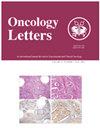A fully validated LC‑MS/MS method for quantifying bevacizumab in plasma samples from patients with NSCLC and its implications in therapeutic drug monitoring.
IF 2.2
4区 医学
Q3 ONCOLOGY
引用次数: 0
Abstract
Given the increasing use of bevacizumab in combinatorial drug therapy for a multitude of different cancer types, there is a need for therapeutic drug monitoring to analyze the possible correlation between drug trough concentration, and therapeutic effect and adverse reactions. An ultra-performance liquid chromatography tandem-mass spectrometry method was then developed and validated to determine bevacizumab levels in human plasma samples. Chromatographic separation was achieved on a Shimadzu InertSustainBio C18 HP column, whereas subsequent mass spectrometric analysis was performed using a Shimadzu 8050CL triple quadrupole mass spectrometer equipped with an electro-spray ionization source in the positive ion mode. In total, three multiple reaction monitoring transitions of each of the surrogate peptides were chosen with 'FTFSLDTSK' applied as the quantification peptide whereas 'VLIYFTSSLHSGVPSR' and 'STAYLQMNSLR' were designated as the verification peptides using the Skyline software. This analytical method was then fully validated, with specificity, linearity, lower limit of quantitation, accuracy, precision, stability, matrix effect and recovery calculated. The linearity of this method was developed to be within the concentration range 5-400 µg/ml for bevacizumab in human plasma. Subsequently, eight patients with non-small cell lung cancer (NSCLC) were recruited and injected with bevacizumab over three periods of treatment to analyze their steady-state trough concentration and differences. To conclude, the results of the present study suggest that bevacizumab can be monitored in a therapeutic setting in patients with NSCLC.经全面验证的 LC-MS/MS 方法,用于定量检测 NSCLC 患者血浆样本中的贝伐珠单抗及其在治疗药物监测中的应用。
鉴于贝伐珠单抗越来越多地用于多种不同癌症类型的联合药物治疗,因此需要进行治疗药物监测,以分析药物谷浓度与治疗效果和不良反应之间可能存在的相关性。因此,我们开发并验证了一种超高效液相色谱串联质谱法,用于测定人体血浆样本中的贝伐珠单抗水平。色谱分离采用岛津 InertSustainBio C18 HP 柱,质谱分析采用岛津 8050CL 三重四极杆质谱仪,配备正离子模式电喷雾离子源。使用 Skyline 软件对每种代用肽进行了三次多反应监测,其中 "FTFSLDTSK "被用作定量肽,而 "VLIYFTSSLHSGVPSR "和 "STAYLQMNSLR "则被指定为验证肽。然后对该分析方法进行了全面验证,计算了特异性、线性、定量下限、准确度、精密度、稳定性、基质效应和回收率。该方法的线性范围为人体血浆中贝伐珠单抗的浓度范围 5-400 µg/ml。随后,研究人员招募了八名非小细胞肺癌(NSCLC)患者,在三个疗程内注射贝伐珠单抗,分析其稳态谷浓度及其差异。总之,本研究的结果表明,贝伐珠单抗可以在非小细胞肺癌患者的治疗环境中进行监测。
本文章由计算机程序翻译,如有差异,请以英文原文为准。
求助全文
约1分钟内获得全文
求助全文
来源期刊

Oncology Letters
ONCOLOGY-
CiteScore
5.70
自引率
0.00%
发文量
412
审稿时长
2.0 months
期刊介绍:
Oncology Letters is a monthly, peer-reviewed journal, available in print and online, that focuses on all aspects of clinical oncology, as well as in vitro and in vivo experimental model systems relevant to the mechanisms of disease.
The principal aim of Oncology Letters is to provide the prompt publication of original studies of high quality that pertain to clinical oncology, chemotherapy, oncogenes, carcinogenesis, metastasis, epidemiology and viral oncology in the form of original research, reviews and case reports.
 求助内容:
求助内容: 应助结果提醒方式:
应助结果提醒方式:


